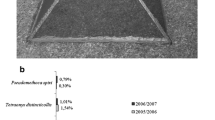Abstract
Results of experiments covering a period of 3 years and using 27 traps in 1974 and 51 traps in 1975–76 on 8 sites situated at an altitude of 1,100 to 1,500 m a.s.l. are presented. During this period the following amount of males were captured: 813 in 1974, 1,524 in 1975 and 1,474 in 1976. From the gathered data it is concluded that even the very low population density during the time of latency shows variations from one site to the other, as well as fluctuations.
Zusammenfassung
Die Resultate beziehen sich auf 3jährige Untersuchungen mit 27 (1974) und 51 Fallen (1975–76) an 8 Standorten in Höhenlagen von 1100 bis 1500 m ü. M. Während dieser Zeit wurden insgesamt 813, 1524 und 1474 Männchen angelockt. Aus den Ergebnissen geht hervor, daß die Populationsdichte der Nonne in der Latenzzeit von Standort zu Standort erhebliche Unterschiede aufweist und Fluktuationen unterworfen ist.
Résumé
Les résultats se rapportent à des expériences effectuées durant 3 années avec 27 pièges (en 1974) et 51 pièges (en 1975–76) sur 8 stations situées entre 1100–1500 m d'altitude. Au cours de cette période on a capturé la première année 813 mâles, la deuxième 1524 et la troisième 1474 mâles. Les données expérimentales permettent de conclure que même durant la période de latence, la densité de la population varie d'une station à l'autre et qu'elle est également soumise à des fluctuations.
Riassunto
I risultati si riferiscono a esperimenti effettuati nel corso di tre anni con 27 trappole (nel 1974) e 51 trappole (nel 1975–76) in otto stazioni situate fra 1100 e 1500 metri di altezza. Sono stati catturati nel primo anno 813 maschi, nel secondo 1524 e nel terzo 1474 maschi. I risultati raccolti permettono di concludere che — anche durante il periodo di latenza — la densità della popolazione varia da una stazione all' altra e inoltre presenta fluttuazioni di anno in anno.
Similar content being viewed by others
Literaturverzeichnis
Beroza, M.;Bierl, B. A.;Tardif, J. G. R.;Cook, D. A.;Paszek, E. C., 1971: Activity and Persistence of Synthetic and Natural Sex Attractants of the Gypsy Moth in Laboratory and Field Trials. J. econ. Entomol.64, 6, 1499–1508.
Bierl, B. A.;Beroza, M.;Collier, C. W., 1970: Potent Sex Attractant of the Gypsy Moth: Its Isolation, Identification, and Synthesis. Science170, 87–89.
Bierl, B. A.;Beroza, M.;Adler, V. E.;Kasang, G.;Schröter, H.;Schneider, D., 1975: The Presence of Disparlure, the Sex Pheromone of the Gypsy Moth, in the Female Nun Moth. Z. Naturforsch.30c, 672–675.
Boness, M.;Schulze, W.;Skatulla, U., 1974: Versuche zur Bekämpfung der Nonne,Lymantria monacha L. mit dem synthetischen Pheromon Disparlure. Anz. Schädlingskde., Pflanzen-Umweltschutz47, 119–122.
Dyk, A., 1933: Dykova kontrola mnišky [Dyksche Nonnen-Kontrolle]. Lesn. práce12, 25–28.
Farský, O., 1938: Nonnenkontroll- und Vorbeugungsmethode nach Professor Forst.-Ing. A.Dyk. Anz. Schädlingdkde14 (5), 52–56; (6), 65–67.
Ferenczy, J.;Holzschuh, C., 1976: Der Sexual-lockstoff Disparlure, ein Helfer gegen die Nonne (Lymantria monacha L.) Allg. Forstztg.87, 109–112.
Görnitz, K., 1949: Anlockversuche mit dem weiblichen Sexualduftstoff des Schwammspinners (Lymantria dispar) und der Nonne (Lymantria monacha). Anz. Schädlingskde22, 145–149.
Hochmut, R.;Skuhravý, V.;Švestka, M., 1977: Kontrola bekyně mnišky (Lymantria monacha L.) feromonovými pastmi v období latence [Kontrolle der Nonne (Lymantria monacha L.) während der Latenz mittels Pheromonfallen]. Lesnictví23, 4, 265–286.
Klimetzek, D.;Loskant, G.;Vité, J. P.;Mori, K., 1976: Disparlure: Differences in Pheromone Perception between Gypsy Moth and Nun Moth. Naturwissenschaften63, 581–582.
Maksymov, J. K., 1976: Biologische Bekämpfung eines Waldschädlings. Neue Zürcher Zeitung4, 39.
Minjajlo, V. A.;Kovalev, B. G.;Kirov, E. I.;Bachvalov, S. A., 1976: Sravnenie privlekatelnosti disparlura, ego trans-izomera i samokP. monacha dlja samcov šelkoprjada — monašenki [Vergleich der Attraktivität von Disparlure, seines Trans-Isomers sowie vonP. monacha-Weibchen auf Nonnen-Männchen]. Zool. Žurnal55, 9, 1410–1411.
Schneider, D.;Lange, R.;Schwarz, F.;Beroza, M.;Bierl, B. A., 1974: Attraction of Male Gypsy and Nun Moths to Disparlure and Some of Its Chemical Analogues. Oecologia (Berl.)14, 19–36.
Schönherr, J., 1972: Die Wirkung von Disparlure auf die Nonne,Lymantria monacha L. Z. ang. Ent.71, 260–263.
Schröter, H. J.;Lange, R., 1975: Untersuchungen über den Einfluß des weiblichen Sexualpheromons auf die Flugaktivität der Männchen von Lymantria monacha L. im Freiland. Z. ang. Ent.77, 337–341.
Schwinck, I., 1955: Freilandversuche zur Frage der Artspezifität des weiblichen Sexualduftstoffes der Nonne (Lymantria monacha L.) und des Schwammspinners (Lymantria dispar L.). Z. ang. Ent.37, 349–357.
Skuhravý, V.;Čapek, M.;Hochmut, R., 1974: Verwendung vonLymantria dispar-Pheromon zur Kontrolle des Vorkommens und der Flugdauer vonLymantria monacha L. undLymantria dispar L. Anz. Schädlingskde., Pflanzen-Umweltschutz47, 58–62.
Skuhravý, V.;Hochmut, R., 1975: Fangergebnisse vonLymantria monacha L. (Lepid., Lymantridae) bei Verwendung von verschiedenen Pheromon-Lockfallen. Anz. Schädlingskde., Pflanzenschutz, Umweltschutz48, 52–55.
Skuhravý, V.;Hochmut, R., 1976: Methodische Probleme des Fanges vonLymantria monacha L. (Lepid., Lymantriidae) in verschiedenen Pheromon-Lockfallen. Anz. Schädlingskde., Pflanzenschutz, Umweltschutz49, 55–58.
Steinbrecht, R. A., 1973: Der Feinbau olfaktorischer Sensillen des Seidenspinners (Insecta, Lepidoptera). Z. Zellforsch.139, 533–565.
Author information
Authors and Affiliations
Additional information
Mit 3 Abbildungen
Rights and permissions
About this article
Cite this article
Maksymov, J.K. Überwachung der Nonne, Lymantria monacha L. (Lepidoptera, Lymantriidae) in den Walliser Alpen mit Hilfe von Disparlure. Anz. Schadlingskde., Pflanzenschutz, Umweltschutz 51, 70–75 (1978). https://doi.org/10.1007/BF01902078
Issue Date:
DOI: https://doi.org/10.1007/BF01902078




